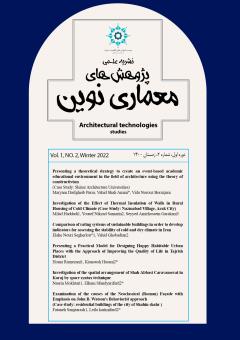Investigation of the spatial arrangement of Shah Abbasi Caravanserai in Karaj by space syntax technique
Subject Areas :Nasrin Mokhtari 1 , Elham Sfandyari fard 2 *
1 - Master of Architecture ,Rasam Institute of Higher Education, Karaj, Iran.
2 - Assistant professor, Department of Architecture, rasam Institue of higher education, Karaj, Iran (Corresponding Author).
Keywords: Historical Buildings, Space Syntax, change of use, Traditional Architecture, Caravanserai, School,
Abstract :
Space syntax is a set of methods and theories that study how the configuration structure of space, organization, and social behaviors interact. Examining the spatial layout is one of the basic strategies for evaluating the usages of any building. This issue is especially evident in historical buildings because the technique of space syntax and drawing justification diagrams makes it possible to analyze the spatial relationships of buildings. Shah Abbasi Caravanserai has long centuries history and has had different uses in different periods. This article examines the spatial arrangement of Shah Abbasi Caravanserai, located in Karaj, in the Safavid and Qajar periods by using the space syntax technique. Also, by considering the change of Shah Abbasi Caravanserai's use to a school in the Qajar period, it seeks to answer the main question: to what extent did the new use correspond to the spatial relations of Shah Abbasi Caravanserai? What are the advantages and disadvantages of changing this user? To answer this question, first, using the descriptive-analytical method and library studies and field surveys, the spatial arrangement of Shah Abbasi Caravanserai in the Safavid and Qajar periods has been studied. Then, drawing diagrams using the space syntax technique and analyzing them based on various influential factors was done. The research result was concluded through analyzing data and comparing the justification diagrams with school diagrams in the Qajar period, indicating that the new spatial arrangement of Shah Abbasi Caravanserai in the Qajar era was done as a result of changing the use to the school. Also, despite some disadvantages because of this change, including a lack of attention to proper access hierarchy, ventilation, and proportions, it is compatible with the spatial relationships of schools of that time to a large extent.
1- حسینی، آ.، و ارژمند، م. (1392). مطالعة تطبیقی معماری کاروانسراهای برونشهری و شهری ناحیة اصفهان در دورة صفویه (مطالعة موردی: کاروانسراهای مهیار و مادرشاه). فصلنامه علمی–پژوهشی مطالعات شهر ایرانی-اسلامی، 12، 45-57.
2- رفيع¬فر، ج.، و لرافشان، ا. (1384). بررسي انسان¬شناختي کاروانسراهاي عصر صفوي. مجلهنامه انسانشناسي، 2(4)، 37-60.
3- ریسمانچیان, ا و بل, س. (1389). شناخت کاربردی روش چیدمان فضا در درک پیکره بندی فضایی شهرها. نشریه هنرهای زیبا- معماری و شهرسازی، 2(43)، 49-56.
4- سهيلي، ج.، و رسولي، ن. (1395). مطالعه تطبیقی نحو فضای معماری کاروانسراهای دوره قاجاریه (مطالعه موردی: کاروانسراهای قزوین و کاشان). هویت شهر،10(26)، 47-60.
5- معماريان، غ، (1385). سيري در مباني نظري معماري. تهران: انتشارات سروش دانش.
6- معماریان، غ.، فیضی، م.، کمالی پور، ح.، و موسویان، م. (1391). ترکیب شکلی و پیکره¬بندی فضایی در مسکن بومی: مقایسه تطبیقی عرصه¬بندی فضای مهمان در خانههای سنتی کرمان. فصلنامه مسکن و محیط روستا، 31(138)، 3-16.
7- معماریان، غ. (1381). نحو فضای معماری. صفه، 12(35)، 75-83.
8- ملازاده، ع.، و بارانی پسیان، و.، و خسروزاده، م. (1391). کاربرد چیدمان فضایی در خیابان ولیعصر شهر باشت. مدیریت شهری, 10(29), 81-90.
9- هيلن براند، ر .(1377). معماري اسلامي. ترجمه اعتصام، ا. تهران: شرکت پردازش و برنامهريزي شهري.
10- Brown, F. E. (1990). Comment on Chapman: some cautionary notes on the application of spatial measures to prehistoric settlements. The social archaeology of houses, 93-109.
11- Hillier, B., & Hanson, J. (1997). The reasoning art. In The 1st International Space Syntax Symposium Proceedings.
12- Hillier, B. (2007). Space is the machine: a configurational theory of architecture. Space Syntax.
13- Orhun, D., Hillier, B., & Hanson, J. (1995). Spatial types in traditional Turkish houses. Environment and planning B: Planning and design, 22(4), 475-498.

